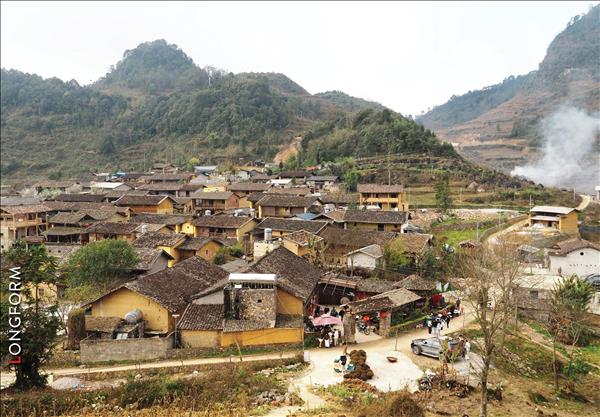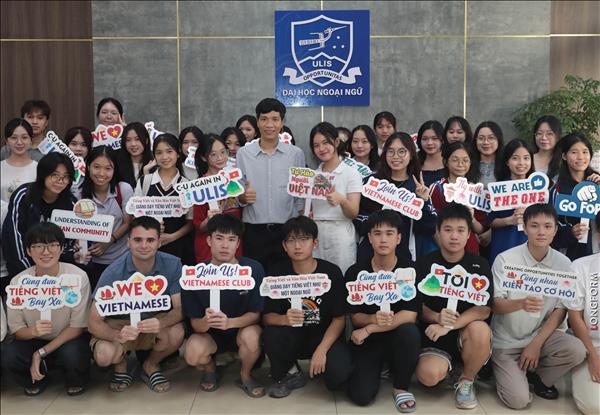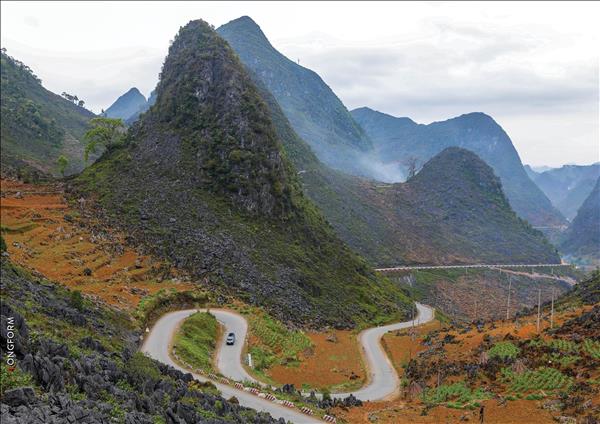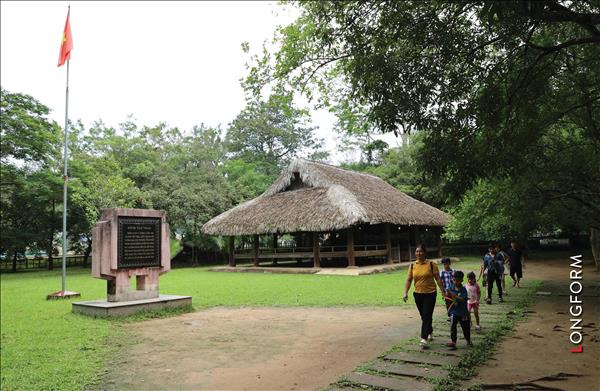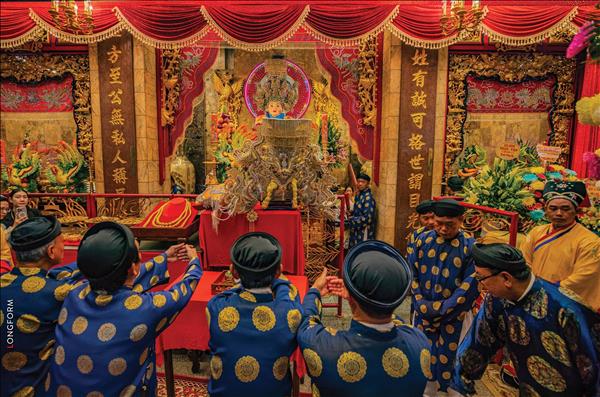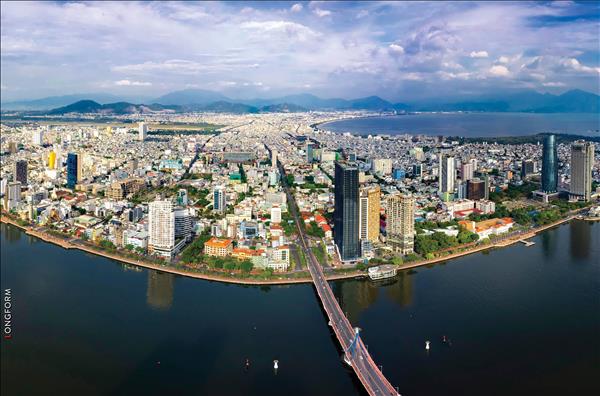Stepping out from a legend
Xuan Pha dancing, which was recognized as a national intangible cultural heritage in 2016, is held on the 10th of the second lunar month in Xuan Pha village, Xuan Truong commune, Tho Xuan district, Thanh Hoa. This is when the village has its traditional annual festival to express gratitude to the gods and to pray for prosperity and bumper crops while entertaining local people after a year of hard work.
The origin of Xuan Pha dancing remains questionable among folklorists but folk artist Bui Van Hung from Xuan Truong commune, Tho Xuan district, who has devoted his whole life to preserving the folk dance, believed Xuan Pha dancing dates back to the Dinh dynasty (968-980).
According to Hung, local legend has it that Dinh Bo Linh was on his way to fight the last of the twelve warlords, named Ngo Xuong Xi, in Binh Kieu, Chau Ai (now Thanh Hoa province). He was stationed in Quan Thanh and sent an envoy to ask for the gods’ support to defeat the enemy and unify the country.
During his mission, the envoy was hit by a storm on the Chu river and had to shelter in Xuan Pha temple. This temple revered Dai Hai Long Vuong, the tutelary god of Xuan Pha village. That night, the envoy met Dai Hai Long Vuong in his dream and he told the envoy how to defeat the enemy. Dinh Bo Linh followed the tricks advised by the god and was victorious in his fight against Ngo Xuong Xi and unified the country. Dinh Bo Linh became the first king of Vietnam and renamed the country Dai Co Viet.
When the country was unified, neighboring countries brought presents to congratulate the king, which included dances. To show his gratitude toward the god of Xuan Pha village, the king offered all these presents to Dai Hai Long Vuong at Xuan Pha temple. He also asked queen Nguyet Nuong, who was originally a royal dancer, to learn the dances and teach them to a group of dancers for annual performances at Xuan Pha temple during the village’s traditional festival.
The dances were then performed each year at Xuan Pha temple under the guidance of queen Nguyet Nuong. In this way, Xuan Pha dancing, or the dances of the five countries, has been handed down from one generation to the next in Xuan Pha village, and is now a unique cultural activity in Thanh Hoa province.
Proof of Vietnam’s development of the ceremonial arts
Xuan Pha dancing features five dances which represent the cultures of five neighboring countries of Dai Co Viet. They are Hoa Lang from Goryeo kingdom or present North Korea; Champa, a tribe south of Dai Co Viet; Ai Lao or present Laos; Ngo Quoc, an ancient Chinese dance; and Luc Hon Nhung, a tribe north of Dai Co Viet.
The dances were based on the ceremonial music of the dynasty and then were simplified into communal and village ritual music, which is a perfect combination of ceremonial art and folk art.
In their performance, Xuan Pha dancers wear white trousers and five-paneled gowns, which are in a different color for each of the five dances.
Hoa Lang dancers perform in blue gowns while Champa performers put on red robes and headgear. Actors in the Luc Hon dance which came from a tribe in the mountains west of Thanh Hoa wear indigo blue robes and performers of the Ngo Quoc dance are in green. Ai Lao dancers wear white robes and trousers with indigo puttees. They also put on a Lao-patterned brocade cloth which crosses from the right shoulder to the left hip.
The attire of the dancers proves that long ago, people used colors to distinguish members from different tribes and their positions in society.
Xuan Pha performers in three of the five dances also put on masks and make-up to make them unrecognizable. Hoa Lang dancers wear a cowhide mask showing the face of a man with a straight and high nose and mustache. They also put on a black pointed leather hat.
Champa performers cover their faces with a red-painted, wooden, Asian faced mask with a short and low nose and eyes made from a peacock feather.
Luc Hon Nhung actors have a white-painted wooden mask which shows the sex and age of the wearer. A mask showing a face with a pointed chin is for women, and a round chin, for men. A mask with many teeth is for old people, and less teeth, for young ones.
Luc Hon Nhung and Ai Lao dancers also wear a basket-shaped bamboo hat which is different in the details. The hat in the Luc Hon Nhung dance has buns of whittled bamboo illustrating the short hair of mountain tribesmen while that of Ai Lao dancers is tied with threads of banyan tree roots symbolizing long hair.
The folk dance has been inherited and protected by the local community in Thanh Hoa for generations.
Hung said for a long time during the war, Xuan Pha did not hold village festivals, but Xuan Pha villagers retained the dances in one way or another.
Xuan Pha dancers were invited by King Bao Dai to perform at a royal trade fair in Hue in 1936, and later to Saigon and Hanoi, according to Hung.
In 1939, Bourin, a French artist, raised funds to introduce Xuan Pha dancing in the US, but this project failed due to World War II.
Xuan Pha dancing, which features a unique and diverse culture and creativity, is performed in Thanh Hoa’s important festive events, including Lam Kinh Festival 2018, the biggest ceremony in the province.
Local people’s love for the folk art can be seen in their saying “Without Xuan Pha dancing, a festival is not the one of Thanh Hoa.”
The folk dance is also being taught to students in extracurricular activities by Hung and other local folk artists in their effort to preserve and promote the original folk art.
Commending the long-standing existence of Xuan Pha dancing, folklorist Phan Cam Thuong said, “In a nation with four thousand years of history, its past is never lost but looms in many cultural forms. Perhaps the legend and the content of the five dances contain some of the most mysterious information from Vietnamese people’s past.”
The origin of Xuan Pha dancing remains questionable among folklorists but folk artist Bui Van Hung from Xuan Truong commune, Tho Xuan district, who has devoted his whole life to preserving the folk dance, believed Xuan Pha dancing dates back to the Dinh dynasty (968-980).
|
The wooden and leather masks used in the Hoa Lang dance. Photo: Cong Dat / VNP Bamboo clapsticks, a main musical instrument in the Ai Lao dance. Photo: Thanh Giang / VNP Musical instruments in Xuan Pha dancing include drums, cymbals and clapsticks. Photo: Cong Dat / VNP Preparing for the Champa dance. Photo: Cong Dat / VNP Luc Hon Nhung dancers prepare their costumes. Photo: Cong Dat / VNP Dancers perform the Luc Hon Nhung dance. Photo: Cong Dat / VNP Beautiful Champa dance. Photo: Thanh Giang / VNP Charming movements in Ngo Quoc dance. Photo: Cong Dat / VNP Hoa Lang is characterized by a fan dance. Photo: Cong Dat / VNP Dancing with clapsticks in the Ai Lao dance. Photo: Cong Dat / VNP |
According to Hung, local legend has it that Dinh Bo Linh was on his way to fight the last of the twelve warlords, named Ngo Xuong Xi, in Binh Kieu, Chau Ai (now Thanh Hoa province). He was stationed in Quan Thanh and sent an envoy to ask for the gods’ support to defeat the enemy and unify the country.
During his mission, the envoy was hit by a storm on the Chu river and had to shelter in Xuan Pha temple. This temple revered Dai Hai Long Vuong, the tutelary god of Xuan Pha village. That night, the envoy met Dai Hai Long Vuong in his dream and he told the envoy how to defeat the enemy. Dinh Bo Linh followed the tricks advised by the god and was victorious in his fight against Ngo Xuong Xi and unified the country. Dinh Bo Linh became the first king of Vietnam and renamed the country Dai Co Viet.
|
Xuan Pha dancing features five dances which represent the cultures of the five neighboring countries of Dai Co Viet. They are Hoa Lang from Goryeo kingdom or present North Korea; Champa, a tribe south of Dai Co Viet; Ai Lao or present Laos; Ngo Quoc, an ancient Chinese dance; and Luc Hon Nhung, a tribe north of Dai Co Viet.
(Source: Vietnam Institute of Musicology)
|
The dances were then performed each year at Xuan Pha temple under the guidance of queen Nguyet Nuong. In this way, Xuan Pha dancing, or the dances of the five countries, has been handed down from one generation to the next in Xuan Pha village, and is now a unique cultural activity in Thanh Hoa province.
Proof of Vietnam’s development of the ceremonial arts
Xuan Pha dancing features five dances which represent the cultures of five neighboring countries of Dai Co Viet. They are Hoa Lang from Goryeo kingdom or present North Korea; Champa, a tribe south of Dai Co Viet; Ai Lao or present Laos; Ngo Quoc, an ancient Chinese dance; and Luc Hon Nhung, a tribe north of Dai Co Viet.
The dances were based on the ceremonial music of the dynasty and then were simplified into communal and village ritual music, which is a perfect combination of ceremonial art and folk art.
In their performance, Xuan Pha dancers wear white trousers and five-paneled gowns, which are in a different color for each of the five dances.
Hoa Lang dancers perform in blue gowns while Champa performers put on red robes and headgear. Actors in the Luc Hon dance which came from a tribe in the mountains west of Thanh Hoa wear indigo blue robes and performers of the Ngo Quoc dance are in green. Ai Lao dancers wear white robes and trousers with indigo puttees. They also put on a Lao-patterned brocade cloth which crosses from the right shoulder to the left hip.
The attire of the dancers proves that long ago, people used colors to distinguish members from different tribes and their positions in society.
|
Folk artist Bui Van Hung draws movements of Xuan Pha dances. Photo: Cong Dat / VNP Do Van Hao, a carpenter in Xuan Pha, makes masks for Xuan Pha dancers. Photo: Cong Dat / VNP Hung teaches the folk dances to school children in Xuan Pha. Photo: Cong Dat / VNP Xuan Pha dancing features five dances. Photo: Cong Dat / VNP The dances are performed in Xuan Pha village’s festival. Photo: Files Xuan Pha dances are performed in Thanh Hoa’s annual Lam Kinh festivals. Photo: Cong Dat / VNP |
Xuan Pha performers in three of the five dances also put on masks and make-up to make them unrecognizable. Hoa Lang dancers wear a cowhide mask showing the face of a man with a straight and high nose and mustache. They also put on a black pointed leather hat.
|
Xuan Pha dancing is a mixed performance of folk singing and dancing which highly respects the strict rules of the dance’s contents. Each of the five dances has clear objectives. The dancing rules are also given with numerous movements using hands, legs and dancing props such as a flag, a fan and a sword. Xuan Pha dances use movements such as jerking shoulders, shaking heads, hopping, and dancing using the whole body, which are rare in the history of dancing.
(Source: Vietnam Institute of Musicology)
|
Luc Hon Nhung actors have a white-painted wooden mask which shows the sex and age of the wearer. A mask showing a face with a pointed chin is for women, and a round chin, for men. A mask with many teeth is for old people, and less teeth, for young ones.
Luc Hon Nhung and Ai Lao dancers also wear a basket-shaped bamboo hat which is different in the details. The hat in the Luc Hon Nhung dance has buns of whittled bamboo illustrating the short hair of mountain tribesmen while that of Ai Lao dancers is tied with threads of banyan tree roots symbolizing long hair.
The folk dance has been inherited and protected by the local community in Thanh Hoa for generations.
Hung said for a long time during the war, Xuan Pha did not hold village festivals, but Xuan Pha villagers retained the dances in one way or another.
Xuan Pha dancers were invited by King Bao Dai to perform at a royal trade fair in Hue in 1936, and later to Saigon and Hanoi, according to Hung.
In 1939, Bourin, a French artist, raised funds to introduce Xuan Pha dancing in the US, but this project failed due to World War II.
Xuan Pha dancing, which features a unique and diverse culture and creativity, is performed in Thanh Hoa’s important festive events, including Lam Kinh Festival 2018, the biggest ceremony in the province.
Local people’s love for the folk art can be seen in their saying “Without Xuan Pha dancing, a festival is not the one of Thanh Hoa.”
The folk dance is also being taught to students in extracurricular activities by Hung and other local folk artists in their effort to preserve and promote the original folk art.
Commending the long-standing existence of Xuan Pha dancing, folklorist Phan Cam Thuong said, “In a nation with four thousand years of history, its past is never lost but looms in many cultural forms. Perhaps the legend and the content of the five dances contain some of the most mysterious information from Vietnamese people’s past.”
|
Xuan Pha dancing has a system of unique performances which incorporates diverse forms of art, including dancing, singing, art performance costumes and conveyance of folktales. This is a process of selecting and absorbing the quintessence of other arts. Xuan Pha dancing is the harmony of ceremonial art and folk art.
(Source: Vietnam Institute of Musicology)
|
Story: Thao Vy - Photos: Cong Dat, Thanh Giang & Files

